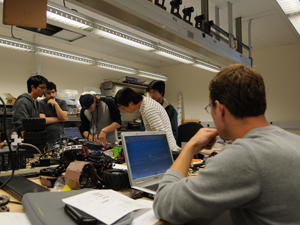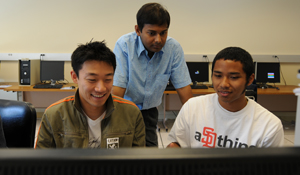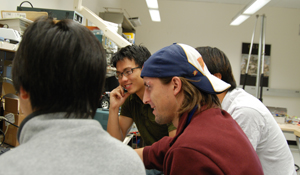News Release
ViaSat-Sponsored ECE 191 Project Takes Engineering Design Course Honor
San Diego, CA, June 18, 2008 -- A project that created a mobile interface for the Race Across America was awarded best project of Â鶹´«Ã½’s spring quarter team engineering design course competition June 13. The presentations also featured three projects sponsored by the UCSD division of the California Institute for Telecommunications and Information Technology (Calit2).
|
The winning project developed a mobile broadcast system for the “chase vehicles” that accompany bicyclists in the Race Across America (RAAM), a continuous five-day bicycle race from Oceanside, Calif., to Annapolis, Md. Satellite and digital communications producer ViaSat, which sponsors a RAAM team, desired an interface that chase vehicles could use to communicate with one another, as well as with the bicyclists and the outside world. Chuck Pateros and Matt Butler of ViaSat worked with three UCSD students – Tim Fair, Michael Inaba and Brian Stieber – to create the system, which featured a 4-channel mixer, USB interface, GPS interface, a rugged public address system and a system for navigation control.
Presenting the team with the award for best project was ECE Professor Pankaj Das. He said he and fellow ECE Professor Clark Guest – who co-teaches ECE 191 -- were impressed that the project had already been implemented into a chase vehicle manned by Pateros, who was in New Mexico at the time of the group’s presentation along with a team of bicyclists.
“This is the first time that a project has gone from concept to application in the real world in one quarter,” Das said. The team received a $100 gift certificate to the UCSD Bookstore for their efforts.
Said team member Tim Fair: “I didn’t expect to win. I thought the other projects were a lot more complicated than ours. But we designed something that’s actually working out in the real world.”
Fair’s colleague, Brian Steiber, pointed out that the device has other applications outside of competitive biking, including use by public safety officers as a more robust PA system.
|
The team of students – JaeYong Kim, Marvin Tu and Phillip Thai -- also developed an algorithm for the device that used infrared sensors for object avoidance. The signals turn the Gizmo truck in the correct direction to avoid any obstacle.
Advisor Jeff Cuenco, who interviewed the team at beginning of quarter, said he was impressed by how much the team of students knew going into the project.
“For being electrical engineers, they were actually quite well-versed in various types of programming,” he said. “Not just embedded linux, but real micro-controller-based embedded coding as well as FPGA [Field Programmable Gate Arrays] experience. So it was actually kind of neat.”
FPGAs are semiconductor devices that contain programmable logic components called "logic blocks," as well as programmable interconnects. Their advantages include a shorter time to market, ability to re-program in the field to fix bugs, and lower non-recurring engineering costs. Applications of FPGAs include digital signal processing, software-defined radio, aerospace and defense systems and a growing range of other areas.
|
Student Bunreth Nhong said Das “was probably the best teacher that we’ve had at UCSD.”
“He would show up at odd hours to help us out,” he added. “He really cared. Who shows up on a Friday afternoon to help out students?”
Nhong said he also highly valued the course itself. “We learn these concepts theoretically, but this class puts it into perspective,” he said. “It’s practical. What we learn stays in our head.”
|
The other groups in the competition included a team that designed and tested two high-gain, high-frequency and low noise left-hand circular polarization patch antennas for satellite phones (mentor Max Sun of Hughes Network Systems advised students Tzu-Yu (Joey) Pao, Stanley Nguyen and Stan Hong on the project).
A team made up of students Homan Chris Karimi, Mike Mesri and Scott Sakurai investigated an efficient and effective method for rekey a network by examining three different multicast protocols for IPsec applications. That team was advised by Tiffany To of Booz Allen Hamilton (a strategy and technology consulting firm) and Richard Phipps of SPAWAR Systems Center, which develops communication technologies for the U.S. military.
By Tiffany Fox, Calit2



